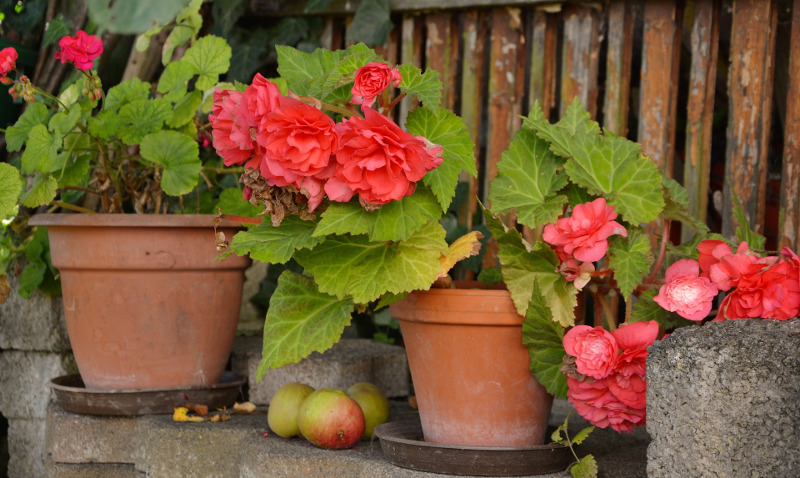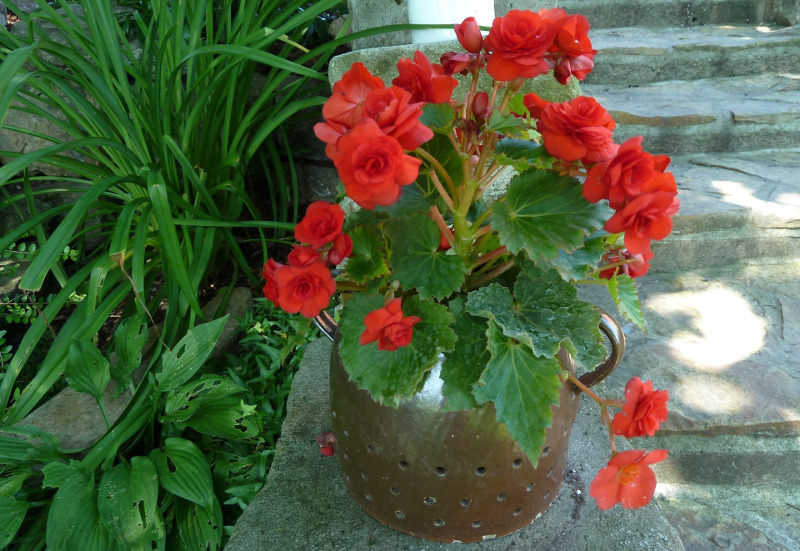Begonias are a fantastic choice for container gardens. They’re a great choice to add as a filler plant. Place containers along walkways, on the edge of entrance stairs, and in shady locations where a splash of color is beneficial to your garden design. Make sure the container you use has a drainage hole. Over-watering begonias is an easy way to kill them.

Planting Begonias in Pots
For outdoor container gardening, create container gardens after the threat of frost has passed. Non-tuberous begonias can be overwintered as houseplants. Pot them up before the temperatures drop into the 40s. Begonias are extremely cold-sensitive. Always use a container with a drainage hole.
Begonias do not like soggy soil. Containers can be located in full sun to shade conditions depending on the variety. Read the label to know what’s best for your plant.
Best Soil For Begonias in Pots
Use high-quality potting soil for begonias grown in containers. It’s optional to mix a little compost into the soil before inserting the plants.
Caring For Begonias in Planters
Begonias make excellent container plants. They prefer to be slightly root bound rather than given room for their roots to sprawl. Let the soil dry out between watering and add a balanced liquid fertilizer every few weeks during the growing season.

Watering Begonias in Pots
Allow the top 2 inches of soil to dry out between watering sessions. Water until the soil is moist but not soggy. Porous containers such as non-glazed clay pots will need to be watered more frequently than plastic, glazed, or other non-porous containers. Containers placed in sunny locations or under overhangs will also need watering more frequently.
If there is a saucer under the container, be sure to empty it after watering and rainfall events. Begonias can withstand short dry periods. They will most likely be okay if you go away for a few days and it doesn’t rain.
Fertilizing Begonias in Pots
Add a balanced liquid fertilizer to container begonias gardens during their active growing season. If you use slow-release granular fertilizer, try to avoid getting it on the stems or leaves. Water after application of granular fertilizer. Water every other week or as directed on the package. Do not apply more fertilizer than is recommended. Adding less fertilizer is healthier for plants than applying too much. Begonias will flower more frequently if you establish a regular feeding habit.
Winter Care For Begonias in Pots
Unless you live in a warm climate where the temperature doesn’t dip below 45 degrees F, your begonias won’t survive outside over the winter months. Move your non-tuberous begonias indoors and treat them as houseplants.
Can Begonias Be Grown Indoors
Dig up tuberous begonias. Allow the top of the plant to die back and the tuber to dry. Add individual tubers to paper bags or wrap them in newspaper. Store begonia tubers individually in paper bags or line them in a single layer atop newspaper. Place the tubers in a cardboard box and store the box in a cool, dark, dry location over the winter.
Move non-tuberous begonias indoors. Repot or spray with insecticidal soap to prevent bringing pests into your home. Place the container in front of a window on the east, south, or west side of your home. Keep the pot away from hot air heating vents. The light levels are too low indoors in northern windows during the winter months. Use grow lights to provide adequate light.
Plants We Recommend
 |
Author Janice Cox - Published 12-09-2021 |
